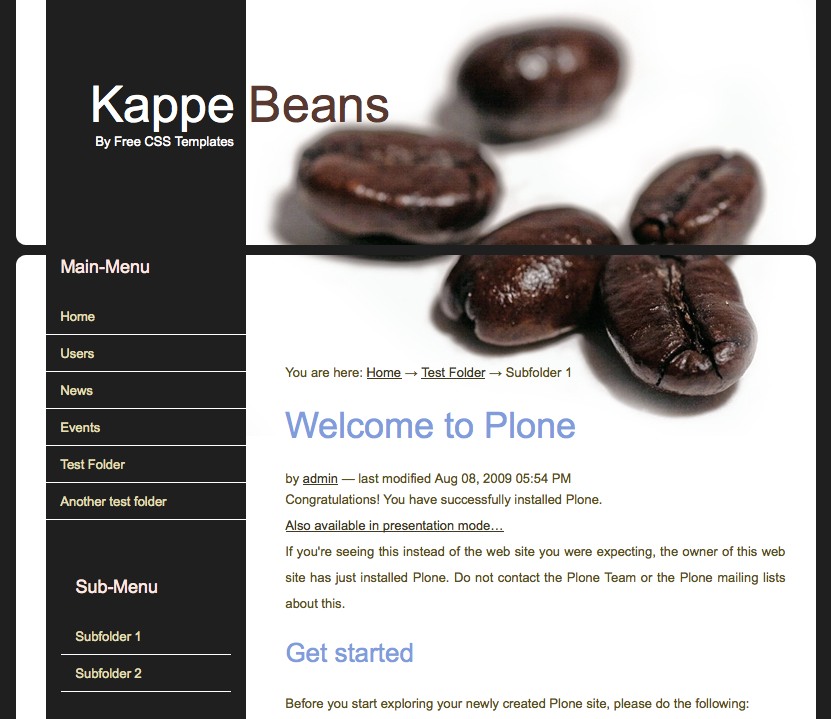Example theme for anthill.skinner
Project description
Introduction
This package provides a public theme for Plone. It is NOT useable using plain plone. It is intended to be used in conjunction with anthill.skinner package.
To remember: This theme relies on the idea that for anonymous users you want to have a flexible theme that is easy to set up and for yourself or content editors you want to unleash the full power of Plone by leaving the interface as is. This paradigma is enough for most Plone websites imho.
You may want to use this package (including anthill.skinner) if you answer one (or all) of the following questions with yes:
Do you have one of the following usecases: Weblog, Photo-Album, Website to present some texts without heavy community features?
Are you afraid of fiddling with the complex Plone template architecture that enforces you to read long and complex howtos in order to create a theme?
Did you already tried to theme Plone but your site still looks more like Plone than your original design?
Do you still ponder about terms like viewlet, content provider, adapter, browser layer, zcml?
Do you think it is a waste of time to adapt a working layout to match the structure of Plone?
Even if you didn’t answer any of these with yes (you are a nerd aren’t you? :-)) then give this package a try. Look at one of these sites - all built on top of anthill.skinner (for Plone 2.5.x) - then decide if this paradigma is for you:
And 100+ more can be found online elsewhere - all built on top of Plone using a public view.
Time matters
One of the most striking points in favour of a public view is mass deployment of websites. What if you have to deploy two portals each week, having only one developer and the design is provided by a plone agnostic web agency?
Without using a public view you can’t do such a task with acceptable costs.
Simplicity matters
Why should one have to fiddle around with the complex Plone templates? To be honest: My favourite product is GloWorm and without I wouldn’t even start searching for the correct template for e.g. the site actions and even with it it is not easy to find the correct templates.
Using a public view means that you can concentrate on the real work: Put a theme on top of Plone and work on functionalitites requested by the customer.
Installation
Include anthill.exampletheme in your buildout
Make sure to have it included in instance zcml and eggs option
Go to portal_quickinstaller and install anthill.skinner
Then install anthill.exampletheme
Click on “Show Preview” on the upper right corner in Plone
How does it look like?

How to create a public skin?
I’m currently creating a paster template that creates all the files and dirs needed to start right away. This template is based on plone3_theme and has no big differences (but important and subtle ones).
But before invoking paster you should have a look at this example in order to see how easy it is to create your own layout. I will describe the steps needed in order to build a public view:
I assume you have a ready to use design ready. I took mine from freecsstemplates.org. I got images, one css file and the index.html.
Create a package (e.g. my.theme) using paster create -t plone3_theme my.theme
Copy all images to browser/images
Copy your css file to browser/stylesheets/main.css
Copy main_template.pt from this package (skins/anthill_exampletheme_custom_templates) to skins/my_theme_custom_templates
Copy publicmenu_levels.pt from this package (skins/anthill_exampletheme_custom_templates) to skins/my_theme_custom_templates
Fire up your favourite editor and open skins/my_theme_custom_templates/main_template
Delete all stuff in the body tag
Copy the contents of your index.html between body tags
Look at how this package uses menu structures and insert menu call at correct places. Also have a look at publicmenu_levels.pt where menu definitions live.
Do not forget to include the “Back to Plone” link!
Now make sure that your profiles/default/skins.xml matches the one from this package. You do need to change the contents in skin-path to be based on publicview and not Plone Default. Yu also need to make sure that the first layer (my_theme_custom_templates) has attribute insert-before=”anthill_skinner_templates”
Now you should be ready to start with your new skin. Make sure to install anthill.skinner first and then install your package. Go to Plone interface and then you should have a new link on the upper right that reads “Show Preview”. Click and if you did all right you should see your shiny layout.
I think you agree that this is very easy and will take you at most an hour to have every design ready. How long will it take to have this design on top of Plone w/o publicview? Don’t know - not my problem :)
Feedback to the author
Changelog
0.1 - 2009-08-08
Initial release
Project details
Release history Release notifications | RSS feed
Download files
Download the file for your platform. If you're not sure which to choose, learn more about installing packages.











